How to Rescue and Care for Baby Sparrow or Birds?
- mktpromeal
- Aug 22
- 9 min read
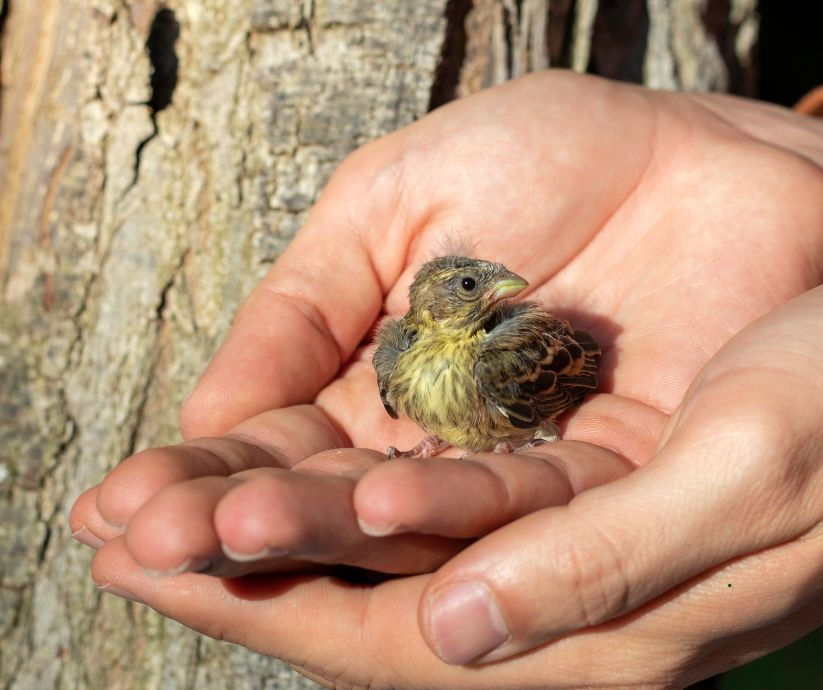
Rescuing and caring for a baby sparrow (also called sparrow chick or fledgling) can be a life-saving act. These fragile birds depend entirely on humans if separated from their parents. With the right diet, warmth, and care, a rescued baby sparrow can grow into a healthy adult ready for release.
Check Before You Rescue
When you find a baby sparrow or chick on the ground, your first thought may be to pick it up immediately. But not all chicks actually need rescuing. Sometimes, they are healthy fledglings (young birds with feathers) that are simply learning to fly. In such cases, the best thing you can do is leave them under the watch of their parents. Rescuing too soon can sometimes harm the bird instead of helping.
Here’s how to decide:
Look for the Nest: When you see a baby sparrow on the ground, first search for its nest nearby. Sparrows usually nest in trees, balconies, or roof corners. If you can safely find the nest, gently place the chick back inside. The parents will continue to care for it.
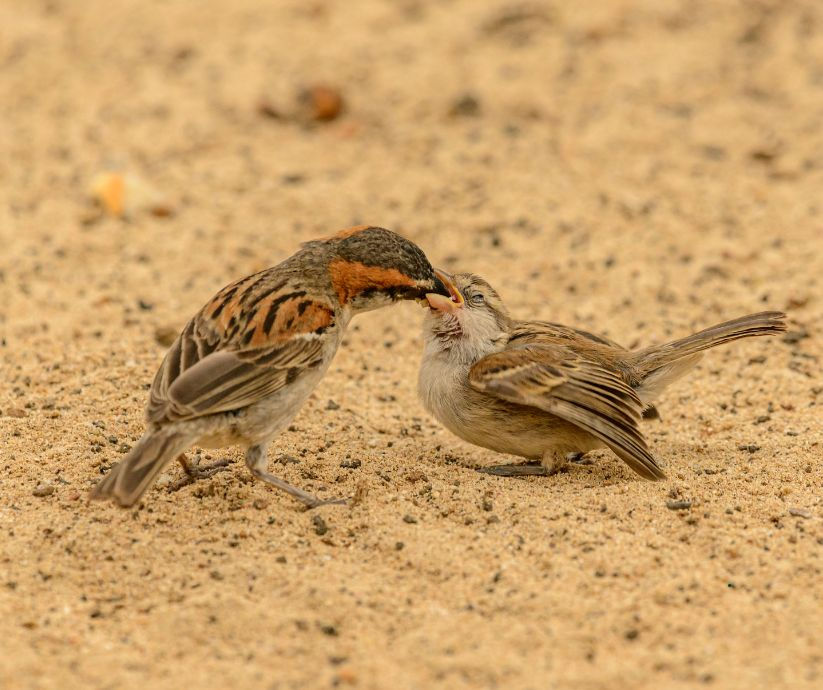
Watch for Parents: If you cannot see a nest, step back and quietly watch the chick for 30 to 60 minutes. In many cases, the parents are still close and may come back with food. This is common with fledglings, which hop on the ground while still being fed by their parents.
If the Chick Is Injured: If the bird is bleeding, has a broken wing, or looks very weak, it needs urgent medical care. In such cases, take the chick to a vet or a local bird rescue group immediately.
If the Chick Is Abandoned: If no parents appear after waiting and the chick is very small with no feathers or closed eyes, it is likely abandoned. Such a chick cannot survive alone, so you can bring it home, keep it warm, and provide proper food.
Expert Note: Always remember that intervention should be the last option. Parents are the best caregivers for baby sparrows. Only step in if the chick is clearly abandoned, unsafe, or injured. Human care is a substitute, but whenever possible, the chick should remain with its natural parents.
How To Make a Safe Home For Baby Sparrow?

When you rescue a baby sparrow, the first thing it needs is a safe, warm, and quiet place. Baby birds are very delicate, so setting up a proper home is very important for their survival.
Nest Box: Take a small cardboard box, shoe box, or basket and prepare it as a nest. Line it with soft cotton cloth or tissues so the chick feels comfortable, just like it would in a real nest. Do not use wool, synthetic cloth, or plastic, because the bird’s tiny legs and claws can get stuck in them.
Warmth: Baby sparrows cannot keep themselves warm, especially when they are very young. If the chick is very small, without feathers, it needs more heat – around 35–40°C. As it grows older and feathers start to cover its body, it needs slightly less heat – around 28–32°C. To provide this warmth, you can use a table lamp, a heating pad, or a hot water bottle wrapped in cloth. Always make sure the chick can move away from the heat source if it feels too hot.
Safety: Keep the box in a quiet and peaceful corner of your house. Do not place it near fans, windows, or noisy areas. Also, keep it away from pets like cats or dogs, because they can harm the baby sparrow. A calm and safe environment helps the chick feel secure and stress-free.
Expert Note: Baby sparrows cannot control their body heat, so a warm and safe nest box is as important as food. Use soft cotton or tissues, never wool or plastic, and always give one warm side and one cooler side so the chick can move for comfort.
What to Feed a Baby Sparrow?

Food plays the biggest role in whether a baby sparrow survives and grows healthy. Unlike adult sparrows, which eat seeds and grains, baby sparrows need a protein-rich diet to build strong bones, muscles, and feathers. In nature, sparrow parents feed their chicks mainly insects because they are packed with protein and easy to digest. When rescuing a chick, we must try to copy the same natural diet.
Good Food
Mealworms (live or dried): Mealworms are the best food for baby sparrows. They are full of protein and healthy fat, which help chicks grow quickly. Dried mealworms can also be used, but they should be soaked in warm water to make them soft before feeding.
Small crickets, waxworms, and superworms: These insects are another great source of protein and energy. They help in healthy bone and feather growth. For small chicks, always cut the insects into tiny pieces to avoid choking.
Mashed fruits like banana, papaya, and mango: Fruits are not the main food but can be given in small amounts. They provide natural vitamins and water, which support the chick’s overall health. Fruits must be mashed into a smooth paste for easy swallowing.
Rehydrated dried insects: If you don’t have access to live insects, dried insects are a good option. Always soak them in water first, so they become soft and safe for the chick to eat.
Foods to Avoid for Baby Sparrows
Some foods that seem harmless to us can be dangerous for baby sparrows. Milk and dairy products are impossible for them to digest and may even be life-threatening. Bread and biscuits provide no nutrition and can block the chick’s crop, making digestion difficult. Rice is also unsafe because it causes bloating and stomach problems. Lastly, hard seeds should never be given to young chicks, as their beaks and stomachs are not ready to handle them. Seeds can only be introduced after 3–4 weeks, once the bird starts feeding on its own.
Expert Tip : When feeding a baby sparrow, always try to mimic nature. Insects like mealworms and crickets should form most of their diet, with small amounts of fruit for extra nutrition. Avoid all human foods like milk, bread, and biscuits. Remember, the right food at the right time gives the chick the best chance of survival. That’s why at Promeal, we recommend using organic live and dried insects, just like sparrows eat in the wild.
Feeding Schedule Of Sparrow Chicks
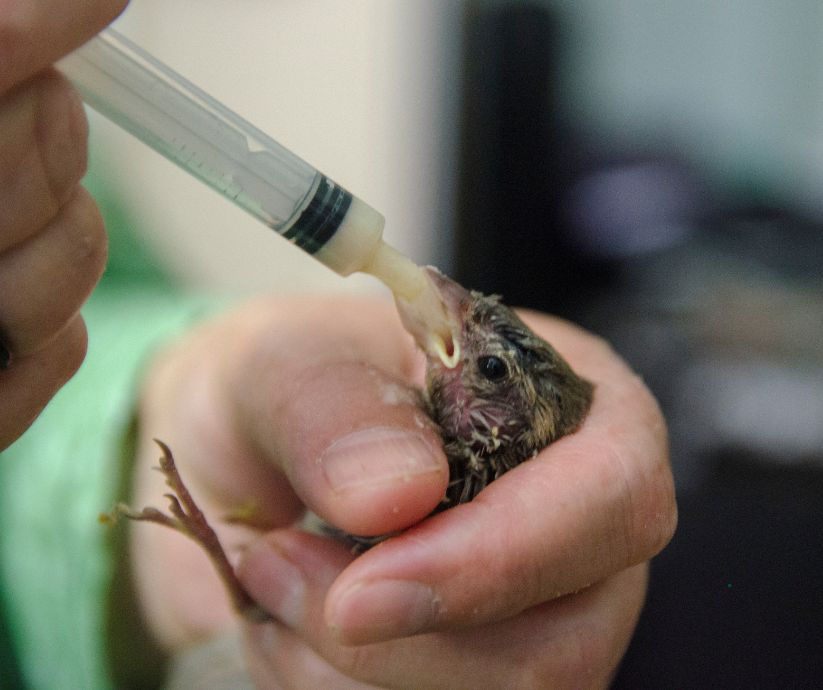
Baby sparrows have very high energy needs because they grow at an incredible speed. Since their stomachs are very small, they cannot store food for long. This is why they must be fed frequently throughout the day.
0–3 Days (Hatchlings): Feed every 20–30 mins. Give only insect paste or finely crushed mealworms.
4–12 Days (Nestlings): Feed every 30–60 mins. Offer tiny insect pieces, soaked dried mealworms, and a little mashed fruit.
13–21 Days (Fledglings): Feed every 2–3 hours. They can now eat whole mealworms, small crickets, and soft fruits.
3+ Weeks (Juveniles): Feed 3–4 times a day. Encourage self-feeding with insects and small seeds in a dish.
Always check the chick’s crop — the small food pouch near its throat. If it looks full, wait before feeding again. Overfeeding can lead to health problems.
Watch Growth and Health

Tracking the chick’s development is essential to know if it’s growing properly. A healthy baby sparrow shows noticeable changes every few days.
Day 1–5: The chick keeps its eyes closed, makes faint chirps, and depends completely on warmth and food.
Day 6–10: Eyes open and small pin feathers start to appear. Chirps become louder, and the chick begs for food more actively.
Day 11–15: The chick begins hopping around, stretching, and flapping its wings. Its feathers cover most of its body.
Day 16–21: At this stage, the sparrow attempts short flights and looks more like a young bird. It shows signs of independence.
Day 22+: The chick can eat by itself, is fully feathered, and is almost ready for outdoor training before release.
If the chick stops opening its mouth for food, keeps its wings drooping, produces watery droppings, or suddenly becomes very quiet, it may be sick. In such cases, immediate care from a vet is needed.
How to Teach a Baby Sparrow Independence?
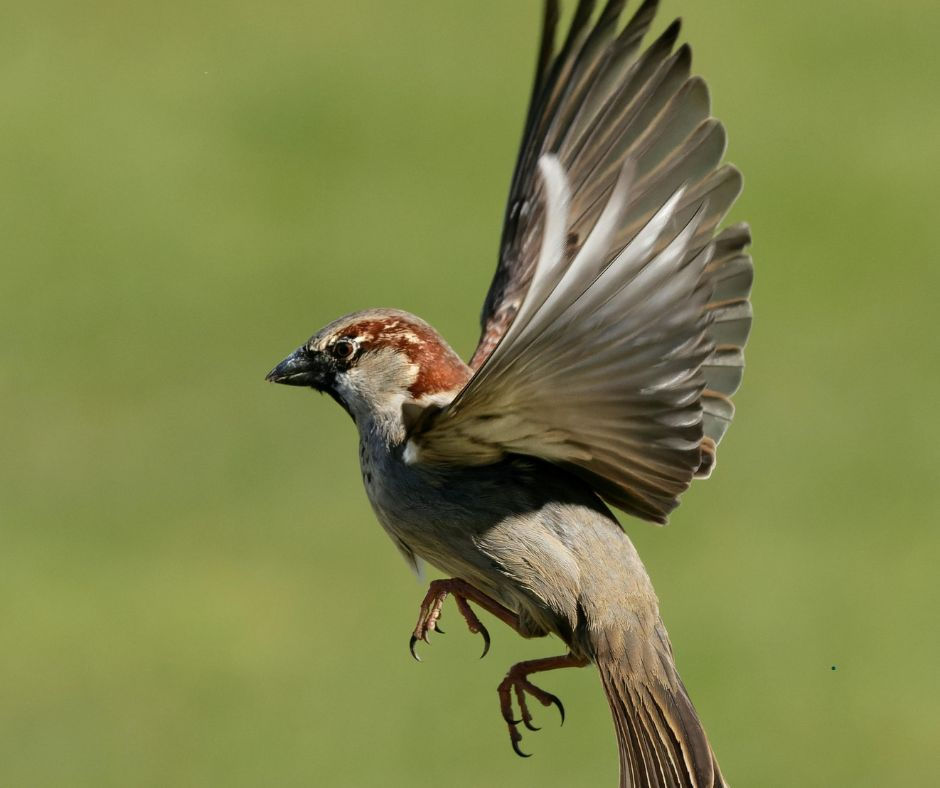
Before the sparrow can be released, it must learn to survive on its own. Independence training is a vital step that prepares the chick for life outside.
Bigger Cage: Once the sparrow starts hopping and flapping its wings, shift it to a larger cage. This gives enough space for wing exercises and short flights. Adding perches helps the bird practice climbing and balancing.
Self-Feeding: Gradually reduce hand-feeding and encourage the chick to eat by itself. Keep insects and small seeds in a shallow dish. Once it starts picking food on its own, it is one step closer to survival in the wild.
Outdoor Practice: Place the cage outdoors for a few hours daily, in a safe spot away from predators. This helps the sparrow get used to natural sunlight, sounds of other birds, and changes in weather. Such practice reduces stress during release.
Release Back to Nature (or Rehoming if Needed)
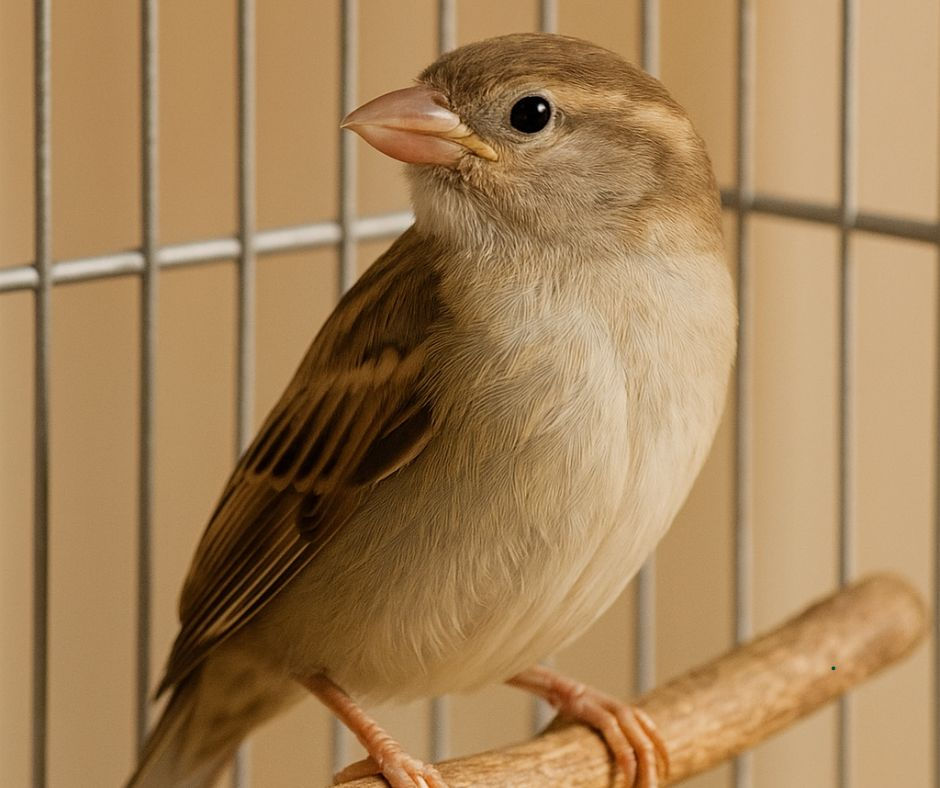
The main goal of rescuing a baby sparrow is to return it safely to the wild. Sparrows are wild birds, not pets, and their true home is outdoors with their flock. Once a chick is healthy, fully feathered, flying well, and eating on its own (usually at 4–5 weeks old), it is ready for release.
Best Time & Place: Morning is ideal, as the bird gets a full day to adjust. Choose a safe area with trees, bushes, and other sparrows around. Avoid open fields, predators, or bad weather.
How to Release ?
Never throw the sparrow into the air. Simply place its cage outside, open the door, and let it come out on its own. For the first few days, leave some food like mealworms, seeds, or fruits nearby for support.
What About Rehoming?
Unlike pets, sparrows cannot be “rehomed.” Their best home is always the wild. If a bird has a permanent injury and cannot survive outdoors, it should be taken to a licensed bird rescue or sanctuary, where experts can care for it safely.
Expert Note: The best home for a sparrow is always the wild. If the chick has been raised on a natural insect-rich diet (like mealworms, crickets, and waxworms), it will be stronger and healthier, with better survival chances after release. Only in cases of permanent injury should a sparrow be placed in a rehabilitation centre — not in a private home.
Common Mistakes to Avoid
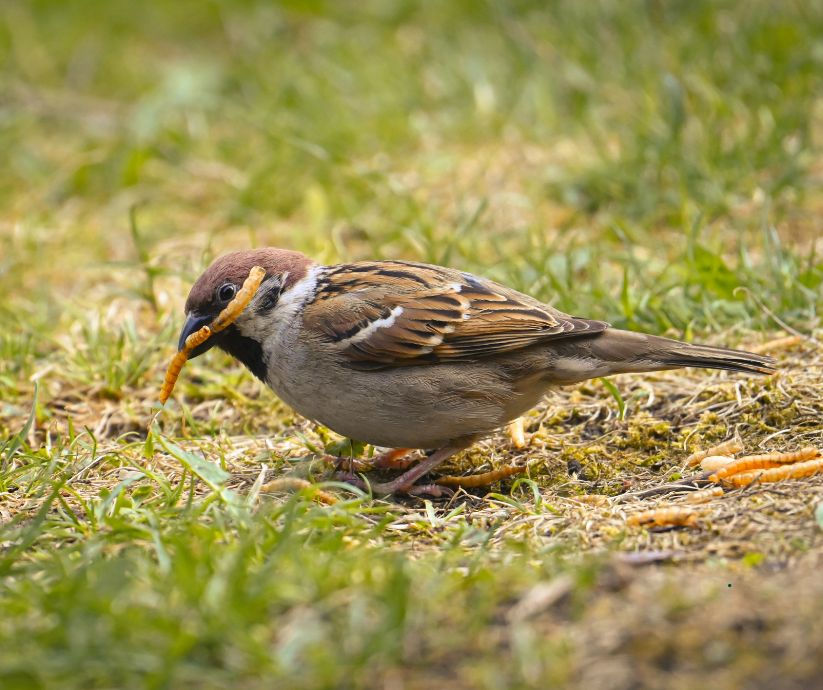
When rescuing a baby sparrow, even small mistakes can affect its survival. Here are the most common errors and why you should avoid them:
Feeding Wrong Foods: Many people feed milk, bread, or rice thinking they are safe. In reality, sparrows cannot digest these foods. Milk can upset their stomach, bread has no nutrition, and rice often causes bloating. These foods weaken the chick instead of helping it grow.
Handling Too Much: Baby sparrows are very fragile. Picking them up too often causes stress and can injure their delicate bones or feathers. Handle only when necessary, such as during feeding or cleaning.
Not Providing Warmth at Night: Young sparrows cannot keep themselves warm. If warmth is not given, especially at night, the chick can become weak and may not survive. Always use a safe heat source like a lamp or hot water bottle wrapped in cloth.
Ignoring Nest Hygiene: A dirty nest box can lead to infections. Since chicks pass waste frequently, the bedding should be changed daily. A clean, dry nest is just as important as food.
Releasing Too Early: Some rescuers release sparrows before they are ready. If a chick cannot fly well or eat on its own, it will not survive outside. Always wait until it is strong, fully feathered, and independent before releasing.
Expert Tip: The safest way to care for a baby sparrow is to follow nature’s example. Keep the chick warm, feed it protein-rich insects like mealworms and crickets, maintain a clean nest box, and only release it once it can fly and eat independently. These simple steps greatly improve the bird’s chances of survival in the wild.
Rescuing a baby sparrow needs patience, warmth, and the right food. By giving it insect-rich meals, keeping it safe and clean, and teaching it to eat and fly on its own, you prepare the chick for life in the wild. With a little care, you can give a sparrow a second chance at freedom.
FAQs About Baby Sparrow Care
Can baby sparrows drink water?
No. Never give water directly; it can cause choking. They get water from insects and fruits.
Can sparrows be kept as pets?
No. Sparrows are wild birds and should always be released once ready.
What is the best food for baby sparrows?
Protein-rich insects like mealworms, crickets, and waxworms are best.
How long until a sparrow can fly?
Usually 3–4 weeks with proper care.
Can dried insects replace live ones?
Yes, but soak them first. Live mealworms are still the best.
How do I know if a sparrow chick is abandoned or alone?
Observe for at least 30–60 minutes. If no parents arrive and the chick looks very small (eyes closed, no feathers), it is likely abandoned and needs human care.
What can I use to make a temporary nest for a baby sparrow?
You can use a small cardboard box, basket, or container lined with soft cotton cloth or tissues. Avoid wool or synthetic fabrics, as they can tangle the chick’s tiny legs.
At Promeal, we provide organic, insect-based nutrition like live and dried mealworms, crickets — the same food sparrow parents naturally feed their chicks. These protein-rich insects support fast growth, strong feathers, and healthy development, giving rescued sparrows the best chance of survival and a successful release back into the wild.




Comments